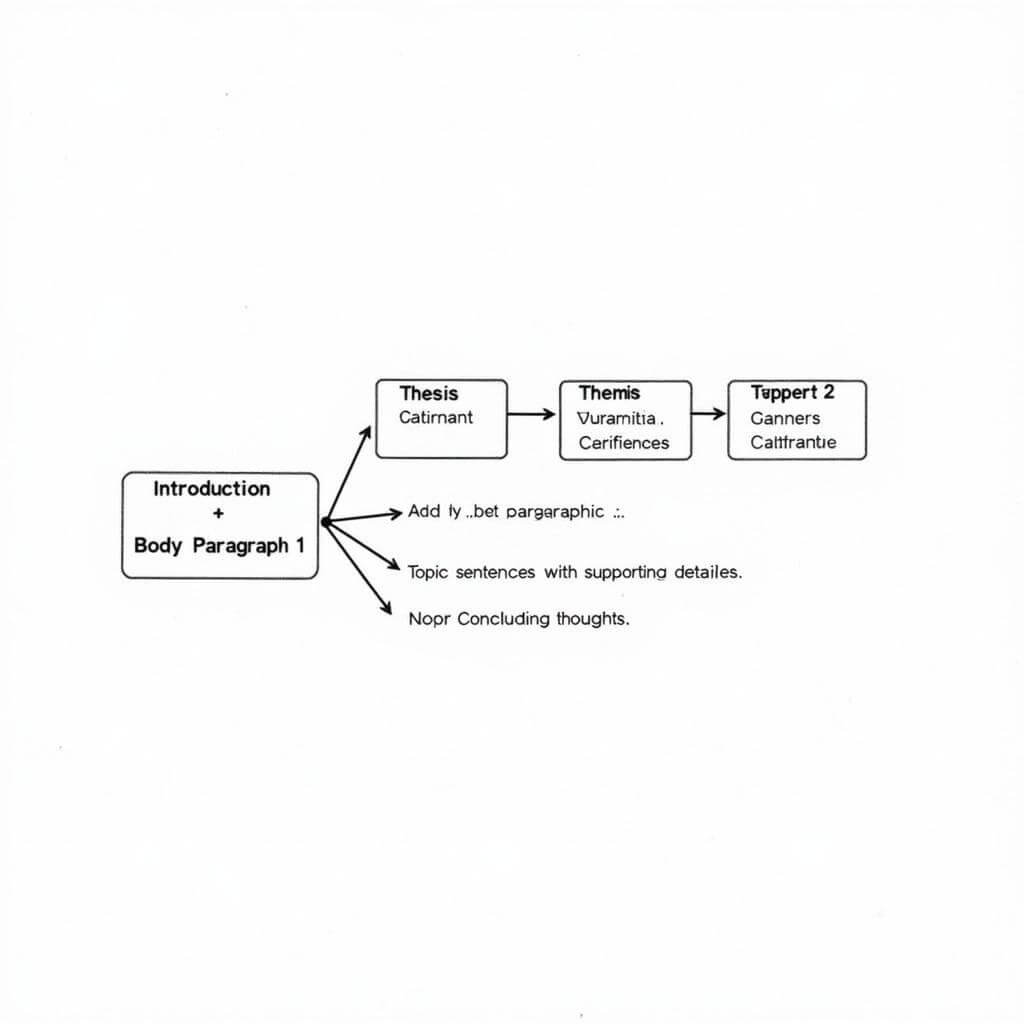IELTS Task 2 essays can be daunting, but with the right structure, you can boost your score significantly. This guide will walk you through the essential components of a well-structured Task 2 essay, providing you with practical tips and strategies to excel in your IELTS Writing exam.
Understanding the Importance of Essay Structure
A clear and logical structure is crucial for IELTS Task 2 success. It not only helps you organize your thoughts but also makes your essay more coherent and easier for the examiner to follow. A well-structured essay demonstrates your ability to present ideas effectively, which is a key criterion in the IELTS marking scheme.

The Four-Paragraph Structure
Most IELTS experts recommend a four-paragraph structure for Task 2 essays. This structure is clear, easy to follow, and allows you to present your ideas in a logical manner. Let’s break down each component:
- Introduction
- Body Paragraph 1
- Body Paragraph 2
- Conclusion
1. Crafting a Strong Introduction
Your introduction sets the tone for the entire essay. It should:
- Paraphrase the question to show understanding
- Present your thesis statement
- Outline your main ideas briefly
Here’s a sample introduction for a Task 2 essay:
In recent years, the rise of online shopping has led to a decline in traditional retail stores. While this trend offers convenience, it also poses challenges to local economies. This essay will explore both the advantages and disadvantages of this shift in consumer behavior.
2. Developing Body Paragraph 1
The first body paragraph should focus on your primary argument or idea. To structure it effectively:
- Start with a clear topic sentence
- Provide supporting details and examples
- Explain how your examples relate to the main point
- Conclude with a linking sentence to the next paragraph
How to improve task 2 body paragraphs offers in-depth strategies to enhance the quality of your body paragraphs.
3. Constructing Body Paragraph 2
The second body paragraph should present a contrasting view or a different aspect of the topic. Follow the same structure as the first body paragraph, ensuring a smooth transition between ideas.
4. Writing a Compelling Conclusion
Your conclusion should:
- Summarize your main points
- Restate your thesis in different words
- Provide a final thought or recommendation
Avoid introducing new ideas in the conclusion. Instead, focus on reinforcing your main arguments.
Tips for Enhancing Your Essay Structure
- Use clear transition words to link paragraphs and ideas.
- Ensure each paragraph focuses on a single main idea.
- Maintain a balance between paragraphs in terms of length and depth.
- Practice writing with more clarity in task 2 to enhance the overall structure of your essay.
Common Structural Mistakes to Avoid
- Skipping the introduction or conclusion
- Writing overly long paragraphs
- Failing to use topic sentences
- Neglecting to link ideas between paragraphs
- Including irrelevant information that doesn’t support your main argument
Dr. Emily Chen, a renowned IELTS expert, emphasizes:
“The key to a well-structured IELTS Task 2 essay is not just about following a template, but about presenting your ideas in a logical and coherent manner. Each paragraph should flow naturally into the next, creating a seamless argument.”
Time Management and Structure
Effective time management is crucial for maintaining a good structure in your Task 2 essay. How to manage time in task 2 essays provides valuable insights on balancing your time between planning, writing, and reviewing your essay.
Adapting Structure to Different Question Types
While the four-paragraph structure works well for most Task 2 essays, you may need to adapt it slightly for different question types. For example, problem-solution essays might require an additional paragraph to fully explore both aspects of the question. Strategies for task 2 problem-solving essays offers specific guidance for this essay type.
Practice and Refinement
Mastering the art of structuring Task 2 essays takes practice. Here are some tips to improve:
- Analyze model essays to understand effective structures
- Practice outlining essays before writing them
- Time yourself to ensure you can complete a well-structured essay within 40 minutes
- Seek feedback from teachers or study partners on your essay structure
Remember, while structure is important, content and language use are equally crucial. Strive for a balance between all aspects of your writing to achieve the best possible IELTS score.
Conclusion
Structuring your IELTS Task 2 essay effectively is a skill that can significantly improve your writing score. By following the four-paragraph structure and implementing the tips provided, you’ll be well on your way to crafting clear, coherent, and high-scoring essays. Remember to practice regularly, focus on clarity and coherence, and adapt your structure as needed for different question types. With these strategies in place, you’ll approach the IELTS Writing Task 2 with confidence and skill.
FAQs
-
How long should each paragraph be in an IELTS Task 2 essay?
Each paragraph should be approximately 50-80 words, with the introduction and conclusion typically being slightly shorter than the body paragraphs. -
Is it necessary to use a four-paragraph structure for all Task 2 essays?
While the four-paragraph structure is widely recommended, you can adapt it slightly for certain question types. The key is to maintain a clear and logical flow of ideas. -
How can I improve the coherence between paragraphs?
Use transition words and phrases to link ideas, and ensure that the last sentence of each paragraph connects to the topic of the next paragraph. -
Should I always write two body paragraphs, or can I include more?
Two body paragraphs are usually sufficient, but if the question requires a more complex response, you can include a third body paragraph. Just ensure you have enough time to develop each point fully. -
How important is essay structure in the IELTS marking criteria?
Essay structure falls under the ‘Coherence and Cohesion’ criterion, which accounts for 25% of your writing score. A well-structured essay can significantly boost your overall band score.